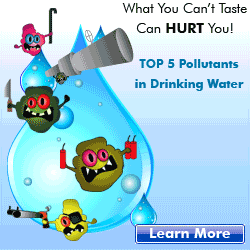
- The TRUTH About America's Water
- Water Pollutants that Cause Illness
- Are Minerals in Water Important for Health?
- Top 5 Drinking Water Contaminants
- Do I Need a Whole House Water Filter?
Regulations for Mercury Contamination in Bottled Water

In short, yes there are. In 1979, the U.S. Food and Drug Administration ruled that bottled water could contain no more than 2 parts per billion (2 micrograms per liter) of mercury. This is identical to the standard set for public drinking water by the U.S. Environmental Protection Agency.
What is mercury? Mercury is a naturally occurring element that is toxic to people and wildlife. When products containing mercury are broken or thrown in the trash, outdoors, or down the drain, mercury cycles through the environment, polluting air and water, and accumulating in fish. You and your family can be exposed to mercury by breathing its fumes, eating contaminated fish, or touching spilled mercury.
What are the dangers of mercury? People may be exposed to mercury from a variety of sources, including drinking water. Too much mercury in the human body can cause serious damage to the brain, nervous system, and kidneys. Young children and developing fetuses are at the greatest risk of the harmful effects of mercury. Inorganic mercury compounds are the most common forms of mercury found in drinking water. Organic mercury compounds, the most harmful forms of mercury, are rarely found in drinking water.
So how is bottled water regulated and kept safe from mercury? Bottled water is a highly regulated product, subject to federal, state, and industry standards. The U.S. Food and Drug Administration (FDA), under the Federal Food, Drug and Cosmetic Act (FFDCA or the Act), regulates bottled water as a food product. This includes packaged water sold in smaller containers at retail outlets as well as larger five-gallon containers distributed to the home and office market. Like all food products except meat and poultry (which are regulated by USDA), bottled water is subject to FDA's extensive food safety and labeling requirements.
The bottled water industry is further regulated on two additional levels: state standards and trade association standards for International Bottled Water Association (IBWA) members. In addition, all bottled water products imported from countries outside of the U.S. must meet the standards established by their own country as well as comply with all of the U.S. regulations.

In compliance with the FDA's standard of quality regulation established in 1974, bottled water manufacturers are also required to ensure that their products adhere to the allowable levels for substances in bottled water, such as that coliform and lead. This regulation includes levels related to microbiological quality, such as the limit on the number of coliform organisms; physical quality, such as turbidity, color, and odor; chemical quality, such as the limits on organic and inorganic chemicals; and radiological quality, such as the limit on radium 226.
Bottled water manufacturers also must ensure that their products meet the FDA-established standard of identity for bottled water products, which was established in 1996. A bottled water product bearing a particular statement of identity, for example, "mineral water," must meet the particular requirements of the standard of identity for mineral water to avoid being misbranded. There are definitions for bottled water, drinking water, artesian water, groundwater, distilled water, deionized water, mineral water, reverse osmosis water, purified water, sparkling bottled water, spring water, sterile water, and well water. If bottled water is misbranded, it is subject to recall.
What is the bottled water tested for? On an annual basis, bottlers must also analyze finished product samples for the following:
- Inorganic contaminants (including pH, nitrate, chloride, fluoride, total dissolved solids)
- Trace metals
- Minerals (including nickel, mercury and silver)
- Volatile organic compounds (VOCs)
- Pesticides and PCBs
- Herbicides
- Synthetic organic compounds (SOCs)
- Gross alpha and beta/radium (radiological analysis).
Many bottlers sell bottled water in states that require additional testing parameters or more frequent testing.
In addition to the tests listed above and frequencies cited, bottlers conduct additional internal quality control testing that includes the testing of containers and closures, which are required quarterly. The testing required for microbiological evaluation, fillers, and the quality of the air in the bottling facility is conducted on an ongoing basis.
While there are differences in the treatment and differences in regulations, both bottled water and municipal drinking water systems both test regularly and vigorously for mercury to keep their product safe.





